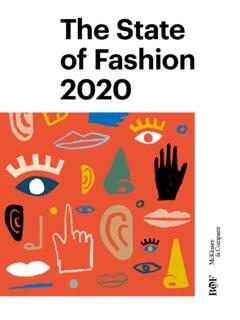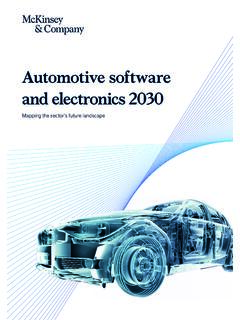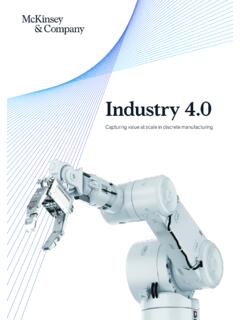Transcription of The 5G Era New Horizons for Advanced Electronics and ...
1 The 5G eraNew Horizons for Advanced Electronics and industrial companiesContentsExecutive summary 4 Introduction 51 A comprehensive view of the 5G value proposition 6 Archetypes of 5G IoT use cases 7 Companies poised to win 8 Myth versus reality in 5G IoT value capture 92 Promising B2B 5G IoT use cases 103 The 5G IoT value proposition for Industry 12 Distinctive 5G IoT use cases in Industry 12 Private-network opportunities 144 Opportunities for Advanced Electronics companies and industrials 15 The 5G IoT module market 15 The 5G IoT component market 195 Strategic implications for Advanced Electronics companies and industrials 20 Advanced Electronics players: Using B2C innovations to launch B2B opportunities 20 Industrial automation players: Becoming 5G ready now 20 Manufacturing players: Focusing on partnerships 21 3 ContentsThe next generation of wireless connectivity, 5G, is becoming a ubiquitous topic but is still the subject of many myths and misconceptions.
2 Although various use cases are emerging, only a few are compelling enough to generate strong demand in the short term. To help Advanced Electronics companies and industrials gain clarity about the best opportunities, we researched over 150 potential 5G use cases, focusing on the 5G Internet of Things (IoT) business-to-business (B2B) market, especially developments expected over the next few years. As part of our analysis, we reviewed the events that occurred during the introduction of 4G and other technologies, since that could provide clues about how the 5G market might evolve. We also interviewed industry experts to see how they viewed 5G s potential companies will derive great value from 5G IoT but it will come in waves The first 5G IoT use cases to gain traction will be those related to enhanced mobile broadband (EMBB).
3 Those for ultra-reliable, low-latency communication (URLLC) will follow shortly thereafter; use cases for massive machine-type communication (MMTC) will take several more years to gain ground. Businesses poised to benefit from the growth of 5G include mobile operators and net-work providers, component and module suppliers, machinery and industrial automation companies, as well as manufacturing opportunities abound, especially in Industry Within the B2B sector, the most relevant short-term opportunities for 5G IoT involve Industry the digitization of manufacturing and other production processes. In this segment, 5G will provide clear performance benefits for several use cases. The Industry segment will account for sales of about 22 million 5G IoT units in 2030, with most applications related to manufacturing.
4 In other B2B segments, such as smart city, smart energy, and connected health, 5G IoT will be the technology of choice only for niche applications. The 5G module market is evolving At launch, 5G IoT modules will cost two to three times as much as 4G modules, but prices will steadily decline. In the B2B sphere, total revenue for 5G IoT modules will increase from about USD 180 million in 2022 to almost USD 10 billion by 2030. By 2030, 5G low-power, wide-area (LPWA) modules are expected to account for almost 30 percent of total B2B 5G IoT module revenues. In terms of use cases, almost all value will initially come from distinctive use cases where 5G IoT provides a clear performance benefit; few manufacturers will incorporate 5G into their devices simply to ensure future readiness.
5 In 2030, 5G will be incorporated into devices primarily because it has become the industry standard; the use of 5G to enable distinctive use cases with clear performance benefits will be less s time for 5G players to revamp their strategies Advanced Electronics companies should initially focus on B2B use cases that are similar to those now being deployed in the business-to-consumer (B2C) sector; over the medium to long term, they should focus on developing chipsets and modules tailored to specific applications. Industrial automation players should first focus on B2B use cases in which they can take advantage of existing B2C components; they should initially focus on early movers in the B2B space. Over the medium to long term, industrial automation players should create a com-prehensive portfolio of 5G IoT products.
6 Manufacturing players that want to move ahead with 5G should create a long list of potential 5G use cases, prioritize the most distinctive ones, find partners to help develop solutions, and initiate rollout at lighthouse factories. Manufacturing companies should consider creating private networks to support their efforts, so they do not have to depend on telecommunications operators. Executive summary4 Executive summaryThe next generation of wireless connectivity has arrived: 5G has the capacity to support a huge number of connections simultaneously while improving speed, latency, reliability, and power consumption for handsets and Internet of Things (IoT) devices. Spectrum auctions are almost complete, the first 5G-ready smartphones have hit the market, and network deployment has begun around the world.
7 Currently, most 5G innovations involve the business-to-consumer (B2C) market, primarily because network operators are attempting to optimize operational costs and handset makers want to differentiate their products. More recently, however, many new opportunities have begun to open in the business-to-business (B2B) with the transition from 3G to 4G, Advanced Electronics companies and industrial players are still uncertain about the benefits of the new technology. Where is the value coming from, and who is going to capture it? What are the use cases where 5G performance enhancements will generate most value and demand? Which applications will most benefit from 5G? Many companies did not ask such questions when 4G emerged and only achieved subpar returns. The danger exists that this scenario could repeat with 5G.
8 To provide greater clarity on future value pools for Advanced Electronics companies and industrials, we investigated the 5G market through 2030, looking at over 150 potential B2B and B2C use cases, including their potential growth and technological requirements. We concentrated on 5G use cases related to IoT in the business sphere, rather than the more predictable market for consumer handsets, because companies are still uncertain about the B2B space both the areas for greatest value capture and the timeline over which 5G IoT applications will gain traction within business. We also looked at the introduction of 4G and other technologies to understand how 5G might evolve and interviewed experts to understand market research allowed us to make projections about use case uptake, demand for modules and components, and other important developments.
9 Notably, we uncovered numerous pockets of growth within the B2B sphere. Advanced Electronics companies that provide 5G modules and components can use this information to optimize their product portfolios. Similarly, the insights will help industrial players determine how they can enhance their operations, products, and business models through 5G are intrigued by 5G because it immensely improves speed, latency, reliability, and power consumption while supporting more device connections (Exhibit 1). Although 5G does not yet provide optimal results for all these dimensions simultaneously because of current technological and infrastructure limitations, it will eventually become the technology of choice for critical communications that require extreme reliability and service quality, including those within industrial settings.
10 1 A comprehensive view of the 5G value propositionExhibit 15G offers many advantages over other wireless technologiesSource: McKinsey analysisNote: Not all performance dimensions can be maximized at the same time. There are trade-offs between speed, range, energy efficiency, and Wi-Fi 6 SpeedLatency andreliabilityConnectionsDevice energyconsumptionRange4G5 GWi-Fi 61NB-IoTSpeed: 100 times faster than LTE, with 1-10 Gb/sLatency and reliability: improvement from 20 msto <1 ms with reliabilityEnergy efficiency: power consumption reduced by 90%Massive connections: 100-fold increase of supported devices to 1 mndevices/km261 A comprehensive view of the 5G value propositionArchetypes of 5G IoT use casesAccording to the 3rd Generation Partnership Project (3 GPP), an organization that develops telecommunication standards, 5G primarily delivers value by enhancing three applications.















